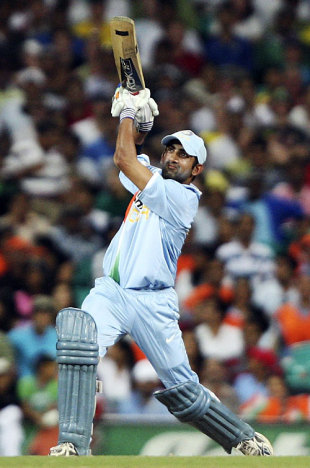Before the knockout
How Rajasthan and Delhi, who will feature in the first semi-final, have fared in the league phase of the IPL
Ashok Ganguly
29-May-2008

| ||
Rajasthan Royals
Most valuable player
Sohail Tanvir, who cost Rajasthan only US$100,000, is the most successful bowler in the competition thus far. His 21 wickets have made him the tournament's highest wicket-taker and they have come at a strike-rate of once every 10 balls. He etched his name in record books when he took 6 for 14 against Chennai Super Kings in Jaipur, the best-ever figures in Twenty20 cricket.
Top performers
Graeme Smith is the rock of Rajasthan's batting; he's scored 416 runs at an average of 52 (second-best among batsmen with more than 300 runs) with a high score of 91 off 51 balls against Chennai. He has formed a formidable opening combine with Swapnil Asnodkar: the duo average 58.83.
Shane Watson is arguably the best allrounder of the tournament with 392 runs at 49 and 13 wickets at 26.46, thrice becoming the Man of the Match.
Yusuf Pathan announced his arrival by reaching fifty off only 21 balls against Deccan Chargers, the fastest half-century in the IPL, before destroying the same team with a 37-ball 68 in a home game. His third Man-of-the-Match award came when he blitzed 48 not out off 18 deliveries against Kolkata Knight Riders.
Captaincy
The dual responsibility of leadership and coaching has not fazed Shane Warne, and he has been inspirational. He's backed unfancied performers from the Indian domestic circuit; Asnodkar, Ravindra Jadeja, and Siddharth Trivedi, and come out in praise of fellow legspinner Dinesh Salunkhe, whose only cricketing credentials coming into the tournament was winning a cricket-based reality show. Experiments such as opening with Asnodkar have been successful (244 runs at 34.85 including a match-winning 34-ball 60 against Kolkata), while Yusuf has been used as a floater according to the match situation. Warne's has also kept up his personal form; his 17 wickets make him the team's second highest wicket-taker, and he has starred with the bat as well, taking 16 runs off the last over bowled by Andrew Symonds in a close win over Deccan.
Strengths and weaknesses
The main reason for Rajasthan's consistency is that different players have turned in match-winning performances. Watson, Yusuf, and Smith may have grabbed headlines, but even Jadeja and Niraj Patel have come good, helping their team knock Mumbai Indians out of the tournament. They have a well-settled bowling line-up with experienced hands - Warne, Tanvir, and Watson - receiving adequate back-up from Trivedi and Munaf Patel, who have taken 23 wickets between them.
One concern is that most of their players don't have big-match experience, something which could affect them in their first knock-out match, when they take on Delhi in the semi-final tomorrow. They have made the Sawai Mansingh Stadium in Jaipur their fortress, winning all their matches there. With all their three losses coming away from home, it remains to be seen whether a neutral venue for the semi-final - the Wankhede Stadium - will affect them.
Stats and trivia

| ||
Delhi Daredevils
Most valuable player
Gautam Gambhir, the second-highest run-getter with 523 runs at 43.58, is the main man in Delhi's powerful top-order. He has scored five half-centuries but surprisingly, he is yet to pick up a Man-of-the-Match award.
Top performers
Virender Sehwag has struck gold in a format ideally suited for him, with 403 runs at 36.63, with a strike-rate of 186.50. He reserved his best for the southern teams, Deccan and Chennai, scoring 94 and 71 respectively.
Shikhar Dhawan has contributed 335 runs with four fifties. He has also been a livewire in the field, among a host of agile Delhi fielders.
Glenn McGrath has shown no signs of having lost his famed accuracy, and gave a lesson in seam bowling against Bangalore Royal Challengers, taking 4 for 29. His overall figures make impressive reading: 12 wickets from 13 matches at 17.91 with an exceptional economy-rate of 6.38.
Captaincy
Sehwag has led Delhi well, but he hasn't given adequate opportunities to his foreign batting recruits - Shoaib Malik and AB de Villiers - which gives the lower order an unsettled look, and he's been found wanting while defending totals. Against Chennai, he gave the last over to Malik and the visitors edged through on the last ball. His decision to give Rajat Bhatia a bowl against Kings XI Punjab proved to be costly when Jayawardene struck a six before the rains came, ensuring that Delhi lost courtesy the Duckworth-Lewis method.
Strengths and weaknesses
Delhi's top three batsmen has been their biggest asset. They have accounted for an amazing 62% of their runs, and a majority of their wins feature significant knocks by Gambhir, Sehwag or Dhawan. Their right-arm seam attack is led by McGrath, and his apprentices, Yomahesh and Farveez Maharoof, have enhanced their reputations. Yomahesh, with 14 wickets at 22.85, is the team's highest wicket-taker, while Maharoof has taken as many wickets as McGrath. Amit Mishra, the legspinner, has provided added depth to their bowling and took a hat-trick against Deccan to finish with 5 for 17.
Delhi's dependency on their top three has also been a drawback. Five of their six losses have come when either the first- or second-wicket pair failed to produce even a fifty-run stand. Also, five of their losses have come away from home, which indicates that the team may find it difficult even at a neutral venue.
Stats and trivia
Ashok Ganguly is an editorial assistant at Cricinfo